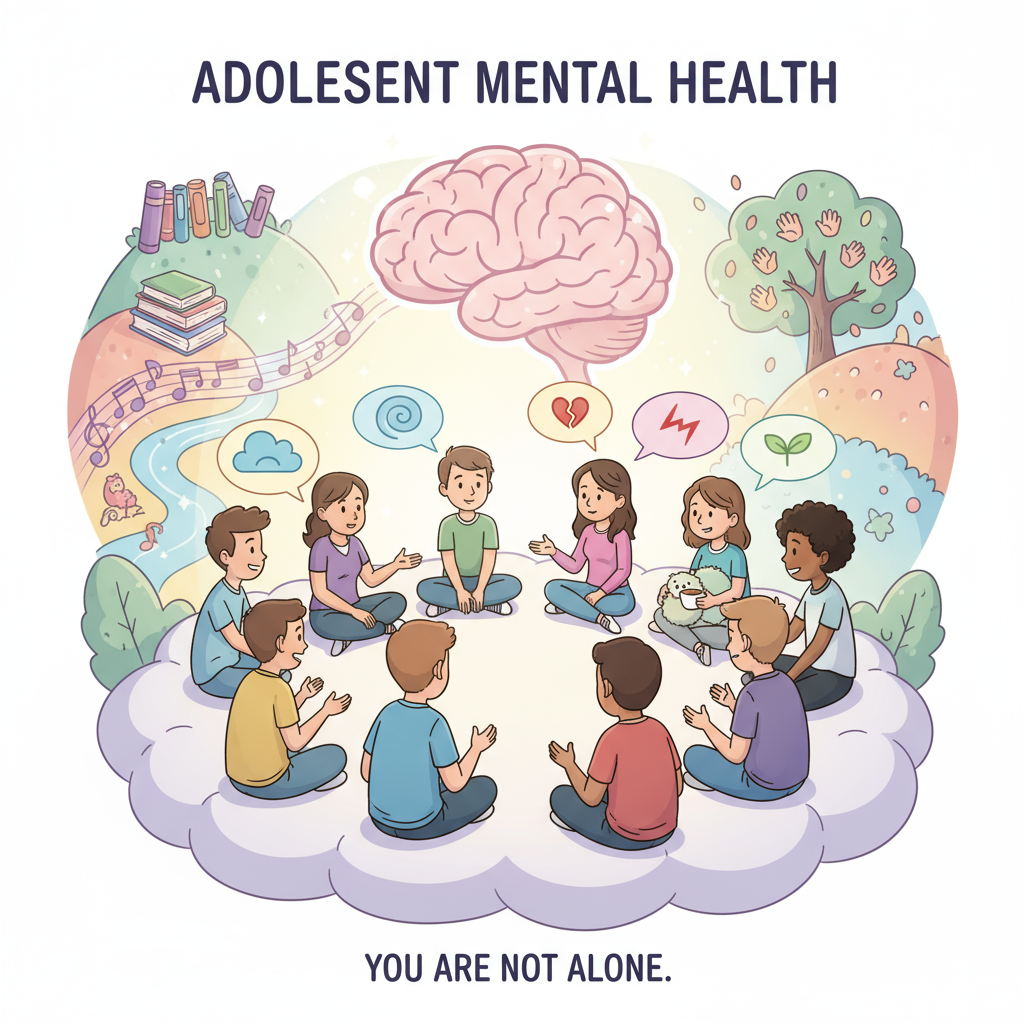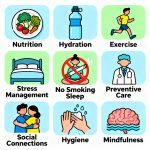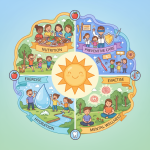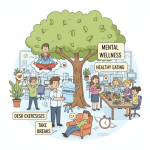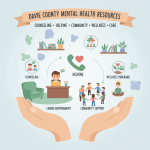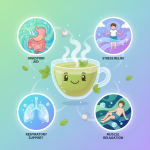Did you know that nearly 1 in 7 adolescents worldwide experiences a mental health disorder each year? According to the World Health Organization (WHO), issues like anxiety, depression, and emotional stress are now among the leading causes of illness and disability in teenagers.
In a fast-changing digital world filled with social media pressures, academic competition, and uncertainty, adolescent mental health has become a global priority. This guide explores the key factors that shape mental well-being in teens — and provides practical, science-backed ways to support it.
🌍 Understanding Adolescent Mental Health
Adolescent mental health refers to the emotional, psychological, and social well-being of teenagers, typically between ages 10 and 19. During this critical developmental stage, young people experience rapid physical, cognitive, and emotional changes.
When these changes intersect with stress, trauma, or social challenges, it can lead to mental health concerns that affect behavior, relationships, and academic performance.
💡 Common Mental Health Issues in Adolescents
-
Depression: Persistent sadness, loss of interest, or withdrawal.
-
Anxiety Disorders: Excessive worry about school, social life, or the future.
-
Eating Disorders: Unhealthy focus on body image or food control.
-
ADHD (Attention Deficit Hyperactivity Disorder): Difficulty focusing or controlling impulses.
-
Substance Abuse: Using drugs or alcohol to cope with stress.
💬 Why Adolescent Mental Health Matters More Than Ever
Adolescence is a formative period — the habits, coping skills, and self-image developed during these years often shape adulthood. Poor mental health at this stage can lead to lifelong consequences like:
-
Reduced academic performance
-
Risky behaviors (e.g., substance use)
-
Suicidal thoughts or self-harm
-
Difficulty forming relationships
-
Chronic mental illness later in life
📊 Global Trend: Mental health-related hospitalizations among teenagers have increased by over 30% in the past decade, highlighting the urgent need for awareness and prevention.
📱 The Impact of Technology and Social Media
Technology offers both benefits and risks for adolescent mental health. While online platforms enable connection and learning, overuse can lead to:
-
Cyberbullying
-
Sleep deprivation
-
Body image issues (due to unrealistic social media comparisons)
-
Addiction-like behaviors
However, when used mindfully, technology can also foster mental health awareness — through digital therapy apps, online support groups, and mindfulness platforms.
✅ Tips for Healthy Tech Use
-
Set daily screen limits.
-
Follow uplifting or educational content creators.
-
Encourage digital detox weekends.
-
Use parental controls for younger teens.
🧩 Key Factors Influencing Teen Mental Health
1. Family Environment
A nurturing home environment with open communication helps adolescents express emotions freely. Families that dismiss emotions may unknowingly increase mental distress.
Tip: Practice active listening and validate your teen’s feelings — even if you don’t fully agree.
2. Academic Pressure
Teens today face unprecedented competition. Overemphasis on grades can lead to chronic stress and burnout.
Tip: Help them set realistic goals and celebrate effort, not just results.
3. Peer Relationships
Positive friendships boost self-esteem, but toxic relationships can cause anxiety or depression.
Tip: Encourage social activities that align with your teen’s interests, like sports, art, or volunteering.
4. Biological Changes
Hormonal shifts during puberty can trigger mood swings and emotional sensitivity. These are normal — but prolonged sadness or irritability may signal something deeper.
Tip: Keep track of changes in sleep, appetite, and social interaction.
5. Global Challenges
From climate anxiety to post-pandemic trauma, modern adolescents face stressors previous generations didn’t.
🌐 Trend Insight (2025): The rise of eco-anxiety and digital burnout has been reported in teens across 40+ countries. Schools are now introducing “mental health literacy” programs to combat stigma and provide early support.
🌱 Practical Strategies to Support Adolescent Mental Health
1. Promote Open Communication
Create a judgment-free zone where your teen feels comfortable discussing challenges. Avoid lecturing; instead, listen actively.
💬 Example phrase: “It sounds like you’ve had a rough day — want to talk about it?”
2. Encourage Physical Activity
Exercise is a natural antidepressant. It releases endorphins that improve mood and reduce anxiety.
Simple Ideas:
-
Join family walks or hikes.
-
Encourage participation in team sports or yoga.
-
Limit sedentary screen time.
3. Prioritize Sleep Hygiene
Teenagers need 8–10 hours of sleep each night, yet many get less due to screens and late-night studying.
Sleep Tips:
-
Create a consistent bedtime routine.
-
Keep devices out of the bedroom.
-
Limit caffeine after 4 p.m.
4. Focus on Nutrition
A balanced diet fuels both body and brain.
Best Foods for Mental Health:
-
Omega-3 rich foods (salmon, chia seeds)
-
Leafy greens for magnesium
-
Whole grains for steady energy
-
Limit sugary snacks
🍎 Encourage healthy meal planning as a shared family activity.
5. Practice Mindfulness and Stress Management
Meditation, journaling, and deep breathing help regulate emotions.
Apps like Headspace, Calm, and Insight Timer offer guided meditations tailored for teens.
🧘 Mindfulness Exercises:
-
5-minute breathing sessions after school.
-
Gratitude journaling every night.
-
Body scan meditation for stress relief.
6. Build a Support Network
Strong connections with peers, mentors, and teachers create emotional stability. Encourage your teen to join clubs, community programs, or counseling groups.
Remember: Social support is a proven buffer against depression and anxiety.
🏫 Schools and Mental Health Education
Educational institutions play a vital role in promoting mental health literacy.
Current trends show schools introducing:
-
Mindfulness breaks between classes
-
On-campus counselors and peer mentors
-
Well-being curriculums that normalize mental health discussions
🌟 Global Example: Finland’s “School Wellbeing Program” integrates emotional intelligence lessons into daily academics — a model being adopted worldwide.
🧠 When to Seek Professional Help
Recognizing when normal teenage behavior becomes a red flag is essential.
Warning Signs:
-
Persistent sadness or hopelessness
-
Sudden drop in grades or motivation
-
Withdrawal from family and friends
-
Self-harm or suicidal thoughts
-
Aggression or extreme mood swings
If you notice these, seek professional support from:
-
A licensed therapist or psychologist
-
School counselors
-
Pediatricians specializing in adolescent care
🩺 Hotlines & Resources:
-
988 Suicide & Crisis Lifeline (U.S.)
-
Child Helpline International (Global)
-
Mind.org (U.K.)
🌟 Current Global Trends in Adolescent Mental Health (2025)
-
AI-Powered Mental Health Apps: AI chatbots like Woebot and Wysa help teens manage emotions in real-time.
-
Teletherapy Growth: Virtual counseling sessions are becoming more accessible and affordable.
-
Focus on Resilience Training: Schools now teach coping skills, mindfulness, and emotional literacy.
-
Destigmatization Movements: Social media influencers are normalizing mental health conversations.
-
Corporate Youth Programs: Businesses are investing in youth well-being to build future-ready talent.
💪 Empowering Teens to Take Control of Their Mental Health
Empowerment begins with awareness and self-care. Encourage teens to:
-
Learn emotional vocabulary (naming feelings reduces distress).
-
Build confidence through creative hobbies.
-
Reach out for help early — there’s no shame in needing support.
❓ Frequently Asked Questions (FAQs)
1. What are the main causes of adolescent mental health problems?
Common causes include hormonal changes, academic stress, family conflict, social pressure, and excessive technology use.
2. How can parents improve their teen’s mental health?
By listening without judgment, promoting healthy routines, and encouraging open discussions about feelings and stress.
3. Can school stress affect adolescent mental health?
Yes. Overwhelming workloads and exam anxiety are major contributors to teenage depression and burnout.
4. How does social media affect adolescent mental health?
It can boost connection but may also increase comparison, anxiety, and cyberbullying risks when overused.
5. When should I seek professional help for my teen?
If your child shows persistent sadness, behavioral changes, or talks about self-harm, consult a mental health professional immediately.
🌈 Final Thoughts: Let’s Normalize Mental Health Conversations
Supporting adolescent mental health is a shared global responsibility. With empathy, awareness, and open communication, we can help teens build resilience, confidence, and emotional intelligence.
The path to well-being starts with one conversation — one moment of listening, one act of understanding.
💬 Call to Action:
If you’re a parent, teacher, or teen reading this, take a small step today: talk about how you feel, check in with someone, or explore mindfulness apps. Every step counts toward a mentally healthier future.
